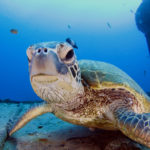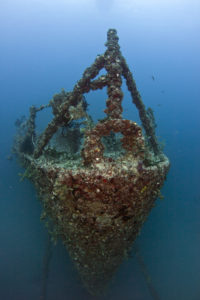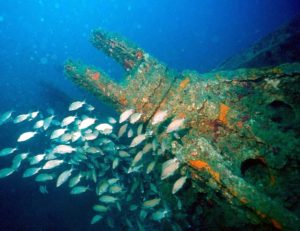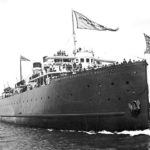In the second of our six-part series on the world’s most dive-able wrecks we’re highlighting the best wreck diving in the United States. (Check out Asia’s best wrecks here). For those with proper certification, wreck diving can offer a window into history. Interior spaces are often eerie and mysterious, sometimes dark and gloomy, and always fascinating to explore. Even if you don’t venture inside a wreck, however, there’s much to discover on deck. Here are our top 10 picks for some of the best wreck diving in the United States.
YO-257

Where: Oahu, Hawaii
The YO-257, an old naval oiler, is the largest and most colorful wreck in Hawaii at 175 feet (54 m) long. After serving in WWII, the Korean War and Vietnam War, Atlantis Submarines scuttled the oiler in 1989 as a showcase for passengers on its submarine tours. It’s since become one of Oahu’s most popular dive sites. There is a complete swim-through at the stern with chances to see sea turtles, eagle rays and trumpetfish.
Maximum depth is 110 feet (34 m) and the top deck is around 85 feet (26 m) deep. Water temperatures range from 73 F (22 C) in January to 82 F (27 C) in July.
USS Spiegel Grove

Where: Key Largo, Florida
The Spiegel Grove is a 510-foot (155 m) former landing-ship dock, now covered in coral and fan growth. You’ll want more than one dive to see it all, including the former helicopter landing pad, gun turrets and two crane arms. Only trained and experienced wreck divers can enter the inner passageways, where you can see the galley’s ovens, sinks and stoves, the mess hall, engine rooms, pump rooms, living quarters and brig.
The top deck is at about 60 feet (18 m) while the maximum depth is around 144 feet (44m). Water temperatures range from 73 F (23 C) in February to 86 F (30 C) in August.
U-352

Where: Morehead City, North Carolina
A German U-boat, the U-352 went down in 1942 during WWII as the result of an attack by the U.S. Coast Guard Cutter Icarus. It rests in a wreck-rich area of North Carolina’s waters known as the Graveyard of the Atlantic, so it’s easy to dive a number of wrecks on one trip. The U-352 was discovered in 1975, though not announced until 1976. Divers can see a conning tower, torpedo hatches and sand-tiger sharks hanging around the wreck. The wreck lays at a 45-degree angle, although the outer hull has disintegrated.
The maximum depth is about 115 feet (35 m) while the minimum depth is around 90 feet (27 m). Water temperatures range from 55 F (13 C) in February to 84 F (29 C) in August.
Lady Luck

Where: Pompano Beach, Florida.
Formerly a New York City sludge tanker called the Newtown Creek, the Shipwreck Park Foundation of Pompano Beach, Florida purchased this vessel in 2016 to sink as an artificial reef. Renamed the “Lady Luck,” the foundation installed various sculptures on the main deck, including sharks playing poker, an octopus playing craps, a mermaid cocktail waitress, huge dice and original art from Dennis MacDonald. There are even occasional underwater poker tournaments for divers.
The minimum depth is around 80 feet (24 m) while the maximum depth is around 134 feet (40 m). Most of the wreck’s highlights are at around 100 feet (30 m). Water temperatures range from 75 F (24 C) from January to March to 84 F (29 C) from July to September.
HMCS Yukon
Where: San Diego, California
The HMCS Yukon is a 366 foot (108 m) long Canadian warship resting in a little over 100 feet of water off the coast of San Diego. The Yukon went down in 2000, and although it was meant to be a planned sinking, nature had other plans. The ship was gutted and cleaned, with holes cut in both the port and starboard sides, meant to create swim-throughs for divers. Towed out to its final resting place the night before, larger-than-expected waves overcame the plywood covering the holes and the ship filled with water, listed, and sank onto its port side. Because the wreck lays on its side, divers can become disoriented quite easily and none without extensive training should attempt any penetration.
Minimum depth is 60 feet (18 m) and maximum depth is 100 feet (30 m). Water temperatures range from 57 F (14 C) in February to 68 F (20 C) in August.
Mary Alice B
Where: Lake Huron, Michigan
The Mary Alice B, a steel 65-foot (20 m) tug, was built in 1931 and went down in 1975 about six miles from Port Sanilac, Michigan. It sits upright with an intact wheelhouse, which is quite rare as divers often removed wheels for artifacts. Visibility inside the wreck can get bad on choppy days and only experienced, properly trained divers should attempt penetration.
The wreck sits in around 90 feet (27 m) of water, making it an advanced dive. Water temperatures range from 34 F (1 C) in February/March to 70 F (21 C) in August.
USS Hogan
Where: San Diego, California
The 314-foot (96 m) destroyer sank off San Diego in 1945 after becoming a target ship for torpedo practice. Previously, the USS Hogan, built in 1919 served in a military capacity in both WWI and WWII. Today, the wreck features abundant coral growth and fish life. Visibility can change quickly, and the dive is often done as a drift, making this site best suited to experienced divers.
The wreck lays between 100 and 125 feet (30 to 38 m) in waters that range from 57 F (14 C) in February to 68 F (20 C) in August.
Keystorm
Where: St. Lawrence River, New York
Built in 1909, the Keystorm sank 1912 after hitting a shoal in the St. Lawrence River. Despite its age, this 256-foot (80 m) steel freighter is mainly still intact. Divers can see the engine room, a corridor along the port side and the propeller. This wreck is shallow enough for divers of all levels, but you must have the correct training, experience and equipment for penetration. Visibility, murky water and current can all present challenges as well.
The vessel lies between 25 and 110 feet (7 and 34 m) in water that ranges from 34 F (3 C) in March to 71 F (23 C) in August.
SS Milwaukee

Where: Lake Michigan, Milwaukee
The SS Milwaukee, built in 1902, sank with all hands on-deck in Lake Michigan in 1929. The ship was a train-car ferry, shuttling train cars back and forth from Milwaukee to western Michigan. Divers can still see train cars filled with cargo such as sinks, toilets and bathtubs. The boiler room and crew quarters are accessible to divers with the correct training.
The SS Milwaukee lays between 90 and 128 feet (27 to 39 m) deep in water where temperatures range from 32 to 68 F (0 to 20 C). Temperatures at depth consistently stay between 38 and 40 F (3 to 4 C) so you’ll want a drysuit.
USCGC Spar
Where: Beaufort, North Carolina
The Coast Guard Cutter USCGC Spar is a frequent hangout for North Carolina’s population of sand-toothed tiger sharks, making for an excellent dive. The ship was purpose-sunk as a dive site in 2004 and the mix of warm and cold currents around the wreck attracts other shark species, as well as spadefish, cobia and occasional giant stingrays.
The USCGC Spar sits between 85 and 110 feet (25 to 34 m) in water that ranges from 58 F (13 C) in February to 84 F (29 C) in August.
The post Best Wreck Diving in the United States appeared first on Scuba Diver Life.
from Scuba Diver Life https://ift.tt/2PL1LjS
No comments:
Post a Comment